Abstract
A 5'-nucleotidase (EC 3.1.3.5) was highly purified from the soluble fraction of rat heart. The preparation appeared homogeneous by the criterion of polyacrylamide-gel electrophoresis. The enzyme was activated by ATP and ADP, and inhibited by Pi. When AMP was used as substrate, the velocity/substrate-concentration plot was sigmoidal. ATP or ADP changed the plot to hyperbolic and decreased S0.5. Pi increased both the sigmoidicity of the plot and S0.5. When IMP was used as substrate, the velocity/substrate plot was hyperbolic. ATP or ADP decreased Km and increased V. Pi changed the plot to sigmoidal and increased S0.5. Within the range of adenylate energy charge observed in surviving mammalian cells (0.7-0.9), the rate of AMP-hydrolysing activity catalysed by the 5'-nucleotidase increased sharply with decreasing energy charge. The highest activity was observed at an energy-charge value of about 0.6. The response was also observed in the presence of Pi. No change in IMP-hydrolysing activity was observed in the physiological range of adenylate energy charge, but in the presence of Pi the activity gradually increased with increasing energy charge. These results suggest the possibility that this enzyme participates in production of adenosine, a vasodilator, during hypoxia and in removal of IMP, which accumulates during the hypoxia, in the heart.
Full text
PDF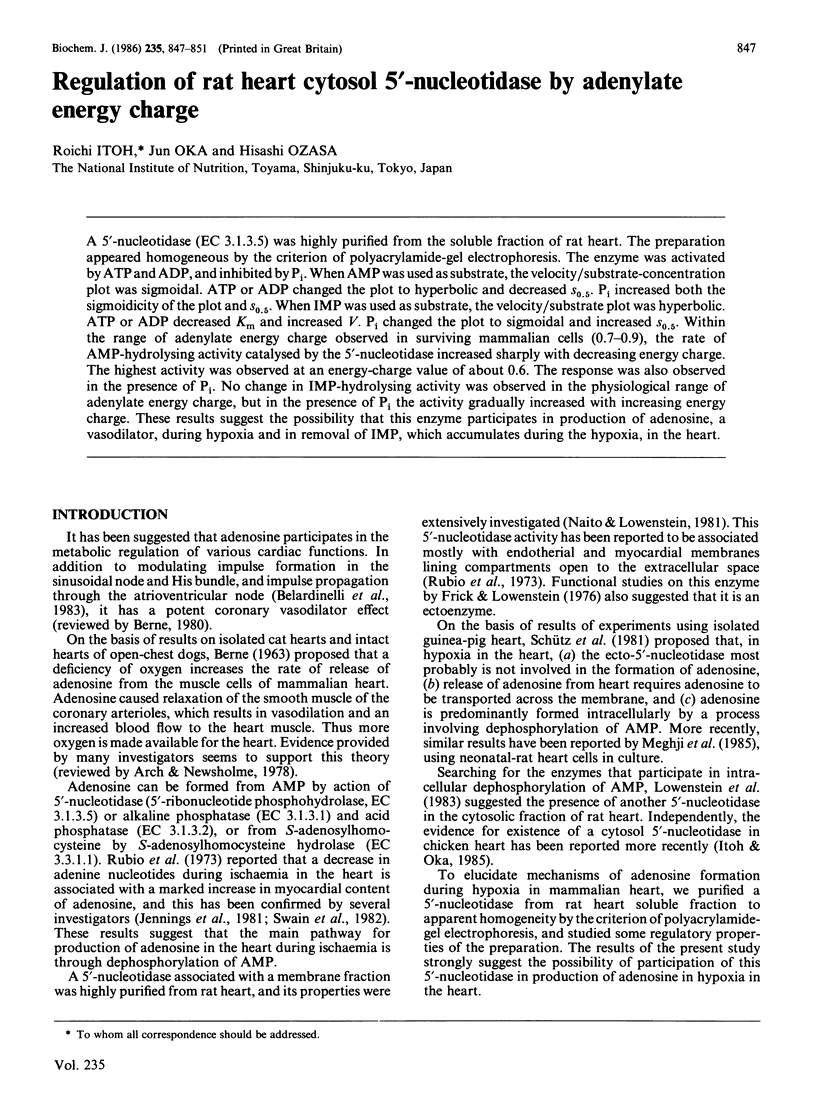
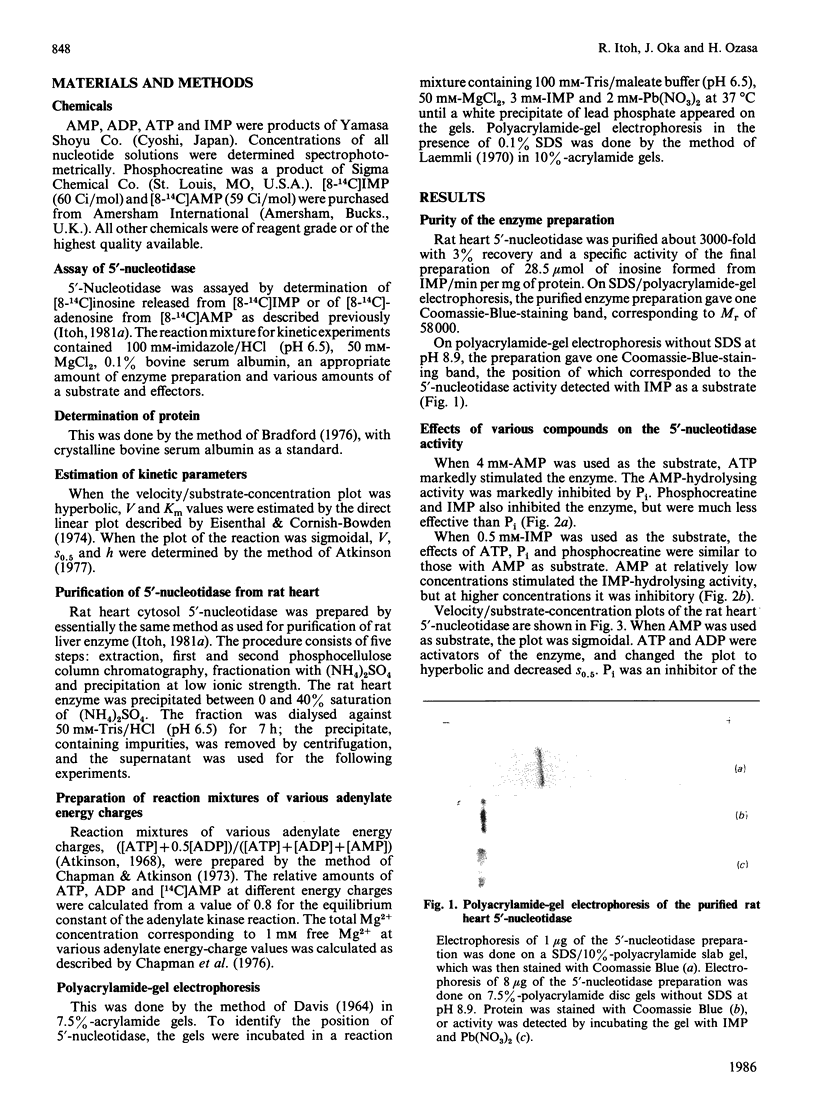
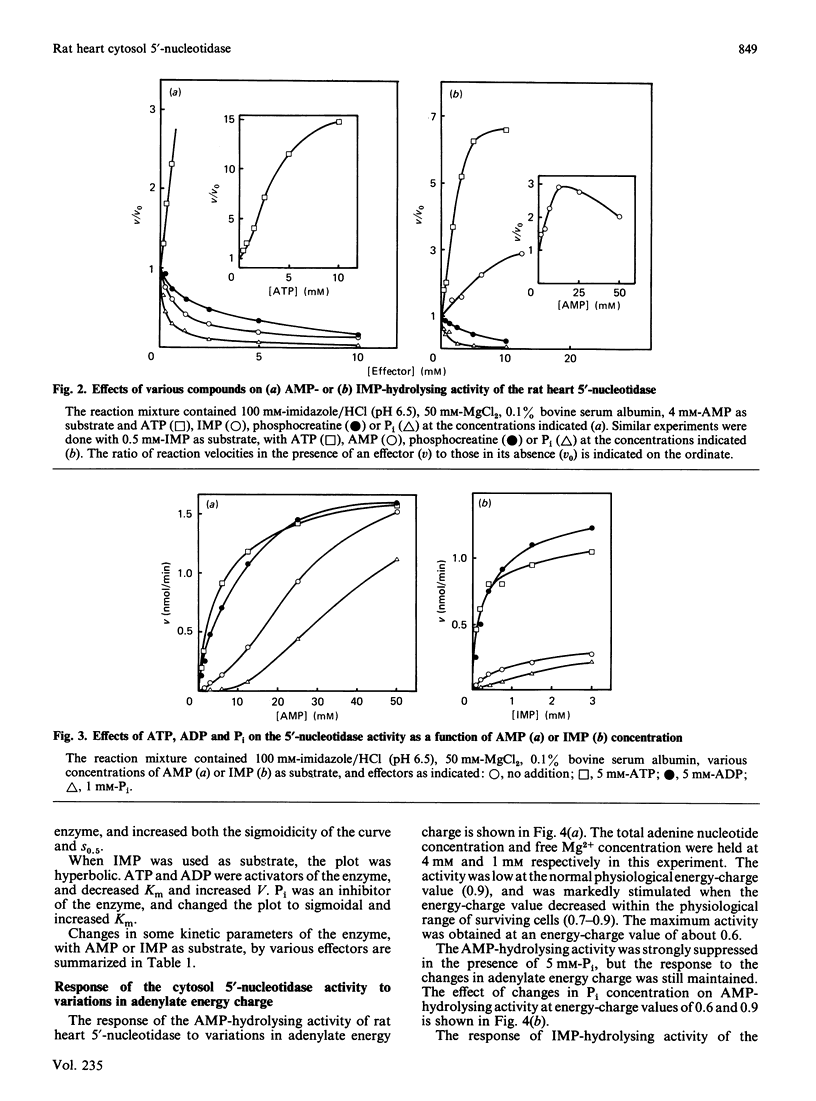
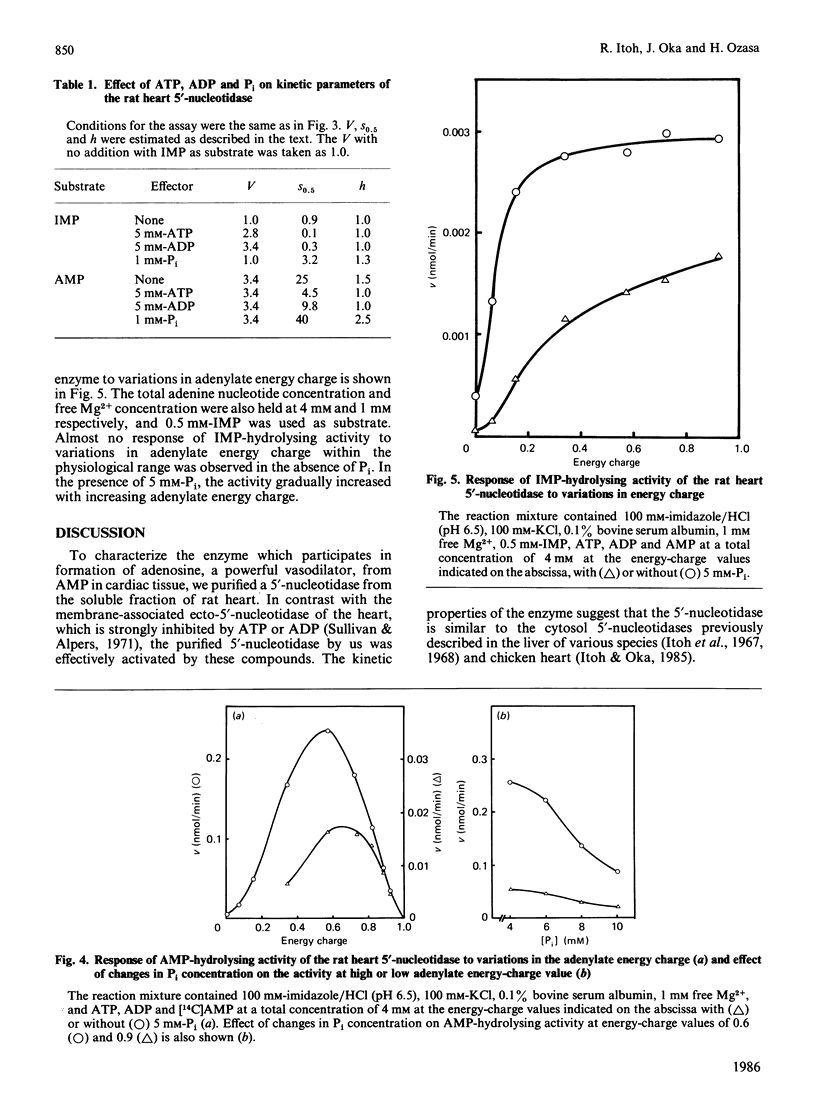
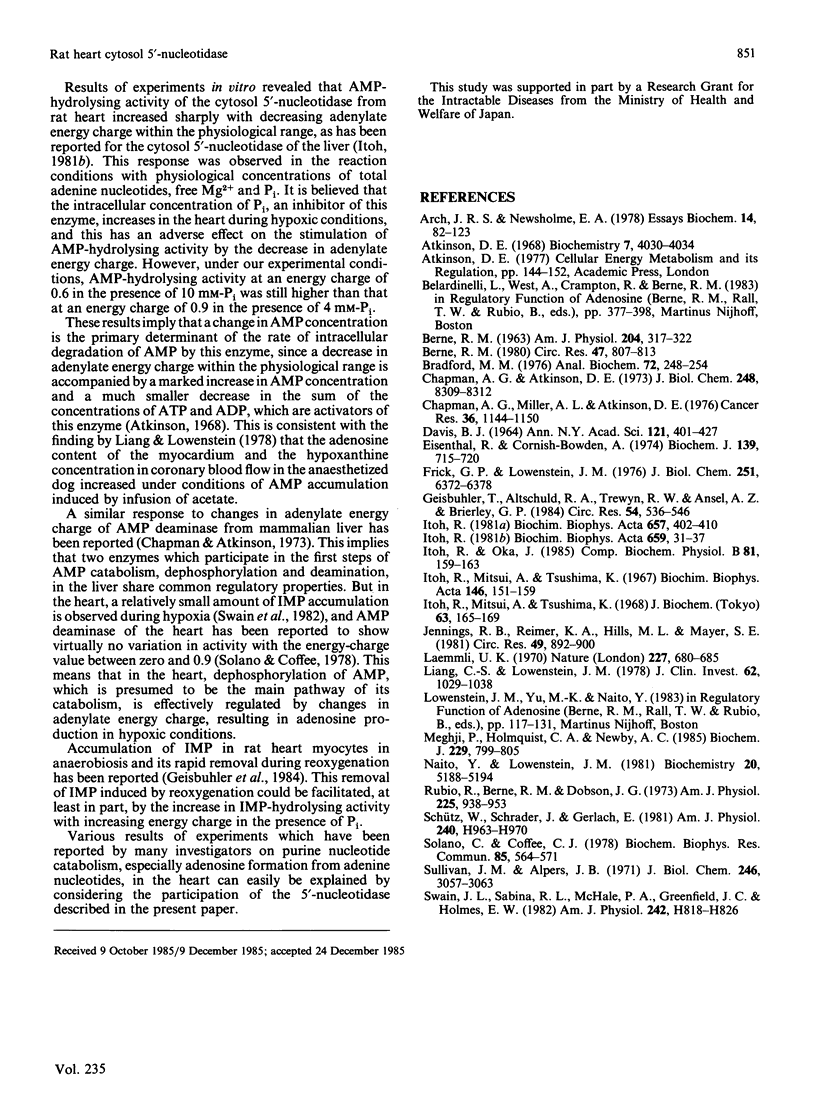
Images in this article
Selected References
These references are in PubMed. This may not be the complete list of references from this article.
- Arch J. R., Newsholme E. A. The control of the metabolism and the hormonal role of adenosine. Essays Biochem. 1978;14:82–123. [PubMed] [Google Scholar]
- Atkinson D. E. The energy charge of the adenylate pool as a regulatory parameter. Interaction with feedback modifiers. Biochemistry. 1968 Nov;7(11):4030–4034. doi: 10.1021/bi00851a033. [DOI] [PubMed] [Google Scholar]
- BERNE R. M. Cardiac nucleotides in hypoxia: possible role in regulation of coronary blood flow. Am J Physiol. 1963 Feb;204:317–322. doi: 10.1152/ajplegacy.1963.204.2.317. [DOI] [PubMed] [Google Scholar]
- Berne R. M. The role of adenosine in the regulation of coronary blood flow. Circ Res. 1980 Dec;47(6):807–813. doi: 10.1161/01.res.47.6.807. [DOI] [PubMed] [Google Scholar]
- Bradford M. M. A rapid and sensitive method for the quantitation of microgram quantities of protein utilizing the principle of protein-dye binding. Anal Biochem. 1976 May 7;72:248–254. doi: 10.1006/abio.1976.9999. [DOI] [PubMed] [Google Scholar]
- Chapman A. G., Atkinson D. E. Stabilization of adenylate energy charge by the adenylate deaminase reaction. J Biol Chem. 1973 Dec 10;248(23):8309–8312. [PubMed] [Google Scholar]
- Chapman A. G., Miller A. L., Atkinson D. E. Role of the adenylate deaminase reaction in regulation of adenine nucleotide metabolism in Ehrlich ascites tumor cells. Cancer Res. 1976 Mar;36(3):1144–1150. [PubMed] [Google Scholar]
- DAVIS B. J. DISC ELECTROPHORESIS. II. METHOD AND APPLICATION TO HUMAN SERUM PROTEINS. Ann N Y Acad Sci. 1964 Dec 28;121:404–427. doi: 10.1111/j.1749-6632.1964.tb14213.x. [DOI] [PubMed] [Google Scholar]
- Eisenthal R., Cornish-Bowden A. The direct linear plot. A new graphical procedure for estimating enzyme kinetic parameters. Biochem J. 1974 Jun;139(3):715–720. doi: 10.1042/bj1390715. [DOI] [PMC free article] [PubMed] [Google Scholar]
- Frick G. P., Lowenstein J. M. Studies of 5'-nucleotidase in the perfused rat heart. Including measurements of the enzyme in perfused skeletal muscle and liver. J Biol Chem. 1976 Oct 25;251(20):6372–6378. [PubMed] [Google Scholar]
- Geisbuhler T., Altschuld R. A., Trewyn R. W., Ansel A. Z., Lamka K., Brierley G. P. Adenine nucleotide metabolism and compartmentalization in isolated adult rat heart cells. Circ Res. 1984 May;54(5):536–546. doi: 10.1161/01.res.54.5.536. [DOI] [PubMed] [Google Scholar]
- Ito R., Mitsui A., Tsushima K. Properties of 5'-nucleotidase from hepatic tissue of higher animals. J Biochem. 1968 Feb;63(2):165–169. doi: 10.1093/oxfordjournals.jbchem.a128757. [DOI] [PubMed] [Google Scholar]
- Itoh R., Mitsui A., Tsushima K. 5'-nucleotidase of chicken liver. Biochim Biophys Acta. 1967 Sep 12;146(1):151–159. doi: 10.1016/0005-2744(67)90081-2. [DOI] [PubMed] [Google Scholar]
- Itoh R., Oka J. Evidence for existence of a cytosol 5'-nucleotidase in chicken heart: comparison of some properties of heart and liver enzymes. Comp Biochem Physiol B. 1985;81(1):159–163. doi: 10.1016/0305-0491(85)90177-4. [DOI] [PubMed] [Google Scholar]
- Itoh R. Regulation of cytosol 5'-nucleotidase by adenylate energy charge. Biochim Biophys Acta. 1981 May 14;659(1):31–37. doi: 10.1016/0005-2744(81)90268-0. [DOI] [PubMed] [Google Scholar]
- Jennings R. B., Reimer K. A., Hill M. L., Mayer S. E. Total ischemia in dog hearts, in vitro. 1. Comparison of high energy phosphate production, utilization, and depletion, and of adenine nucleotide catabolism in total ischemia in vitro vs. severe ischemia in vivo. Circ Res. 1981 Oct;49(4):892–900. doi: 10.1161/01.res.49.4.892. [DOI] [PubMed] [Google Scholar]
- Laemmli U. K. Cleavage of structural proteins during the assembly of the head of bacteriophage T4. Nature. 1970 Aug 15;227(5259):680–685. doi: 10.1038/227680a0. [DOI] [PubMed] [Google Scholar]
- Liang C. S., Lowenstein J. M. Metabolic control of the circulation. Effects of acetate and pyruvate. J Clin Invest. 1978 Nov;62(5):1029–1038. doi: 10.1172/JCI109207. [DOI] [PMC free article] [PubMed] [Google Scholar]
- Meghji P., Holmquist C. A., Newby A. C. Adenosine formation and release from neonatal-rat heart cells in culture. Biochem J. 1985 Aug 1;229(3):799–805. doi: 10.1042/bj2290799. [DOI] [PMC free article] [PubMed] [Google Scholar]
- Naito Y., Lowenstein J. M. 5'-Nucleotidase from rat heart. Biochemistry. 1981 Sep 1;20(18):5188–5194. doi: 10.1021/bi00521a014. [DOI] [PubMed] [Google Scholar]
- Rubio R., Berne R. M., Dobson J. G., Jr Sites of adenosine production in cardiac and skeletal muscle. Am J Physiol. 1973 Oct;225(4):938–953. doi: 10.1152/ajplegacy.1973.225.4.938. [DOI] [PubMed] [Google Scholar]
- Schütz W., Schrader J., Gerlach E. Different sites of adenosine formation in the heart. Am J Physiol. 1981 Jun;240(6):H963–H970. doi: 10.1152/ajpheart.1981.240.6.H963. [DOI] [PubMed] [Google Scholar]
- Solano C., Coffee C. J. Differential response of AMP deaminase isozymes to changes in the adenylate energy charge. Biochem Biophys Res Commun. 1978 Nov 29;85(2):564–571. doi: 10.1016/0006-291x(78)91200-7. [DOI] [PubMed] [Google Scholar]
- Sullivan J. M., Alpers J. B. In vitro regulation of rat heart 5'-nucleotidase by adenine nucleotides and magnesium. J Biol Chem. 1971 May 10;246(9):3057–3063. [PubMed] [Google Scholar]
- Swain J. L., Sabina R. L., McHale P. A., Greenfield J. C., Jr, Holmes E. W. Prolonged myocardial nucleotide depletion after brief ischemia in the open-chest dog. Am J Physiol. 1982 May;242(5):H818–H826. doi: 10.1152/ajpheart.1982.242.5.H818. [DOI] [PubMed] [Google Scholar]



